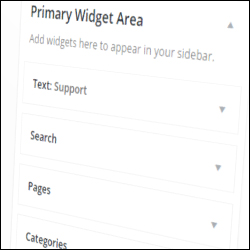 In Part 1 of this tutorial series, we explained the basics of using WordPress widgets.
In Part 1 of this tutorial series, we explained the basics of using WordPress widgets.
In this section you are going to begin configuring various widgets in WordPress.
Widget Configuration
In a default WordPress installation, your site comes with a number of preinstalled active widgets, such as widgets for displaying external links, filter posts by categories, RSS feed content, add content search features, etc.

(By default, your site comes with several built-in widgets)
How To Configure Commonly-Used Sidebar Widgets: Tutorial
In this tutorial series, we will add, configure and reorder s number of WordPress widgets to display in the site’s sidebar, including:
- Add a clickable Contact Us image linking to the contact page.
- Adding a Categories section with a drop down menu.
- Adding a Recent Posts section to display the latest posts.
- Add a list of the site’s most important Pages.
- Display important Links on your sidebar.
- Adding an RSS Feed section.
- Adding a Tag Cloud.
- Configure how Archived Posts display on the sidebar menu.
The Widgets panel is located inside the WordPress administration area and can easily be accessed from the admin menu by clicking on Appearance > Widgets …
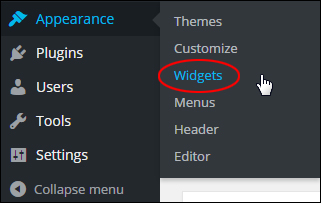
(Widgets Menu)
This opens the Widgets area into your browser window …
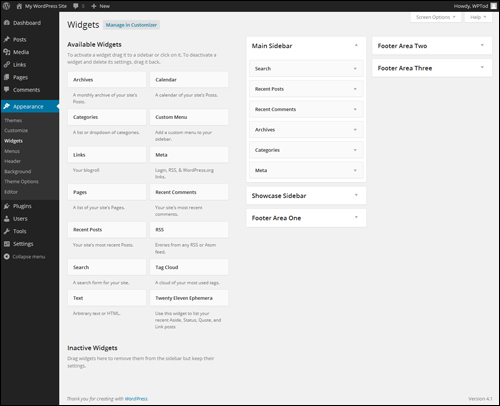
(Widgets Screen)
Let’s start by learning how to configure text widgets …
Add A Text Widget To Your Sidebar Navigation Section
Text widgets are versatile …

(WordPress Text widget)
![]()
Rich Text Widget
From version 4.8 onward, WordPress has added native rich-text editing capabilities to text widgets …
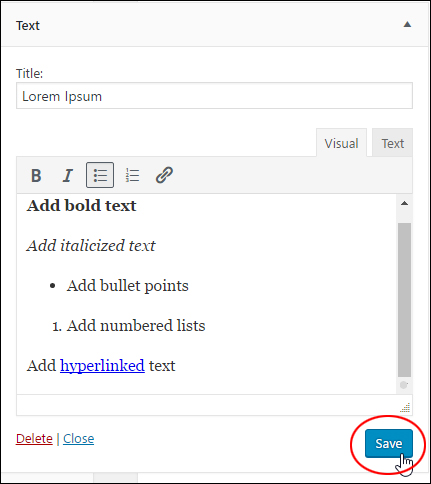
(Rich Text Widget)
This lets you quickly and easily format text, create lists, add emphasis, and insert links into your sidebar text …
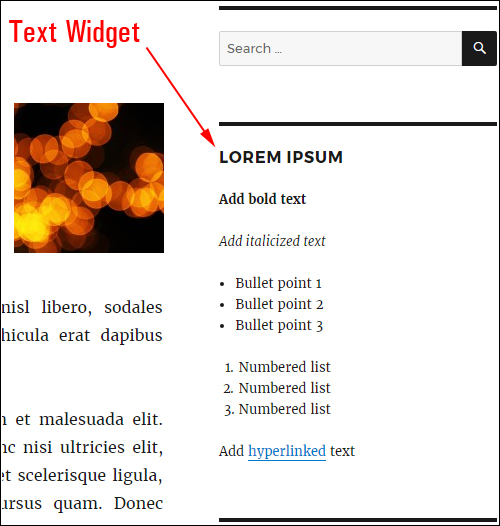
(Format text easily with the new text widget)
Text widgets can be used to add lists of favorite items, images, tips and more to your site … just type in text or insert HTML into the content area. You can also add an optional title in the Title field. Remember to save your settings when done …

(Text widgets are extremely versatile!)
Example: Add A Contact Button To Your Sidebar Menu Using A Text Widget
For this example, we’ll set up a clickable support button on the sidebar area that takes visitors to a page on your site (or an external site, e.g. a helpdesk) where they can contact you for help and support.
First, you will need to create or source a “help button” graphic image that your visitors can click on …

We’ll set up the clickable Help button to display at the top of the sidebar like in the example shown below …
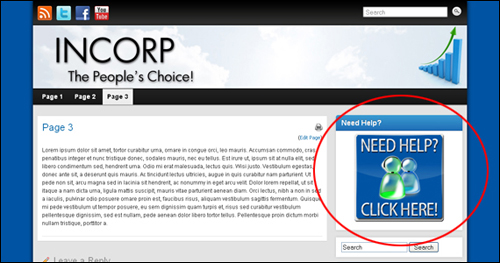
Step 1 – Upload your image.
Upload the button image to a folder on your server and note down the address of your image location.
E.g. …
http://www.yourdomain.com/images/supportbutton.jpg
This information will be required in Step 3.
For visitors to be taken to your contact page when they click on the graphic button, either create a contact page, or have an existing destination page already set up (e.g. a helpdesk). We will link your button graphic to this URL in Step 3 …
Step 2 – Add the support page.
Create a contact page on your site and note the page URL …

Step 3 – Compose your text widget code.
Don’t worry … this sounds a lot more technical than it is. In simple terms, we just need to create the instructions for your clickable button.
Your code can be written a simple text file and should look something like this …

- Replace “http://www.yourdomain.com/contact-us” in the code above with the URL of your contact page location.
- Replace “http://yourimagelocation.com/img/supportbutton.jpg” in the code with the URL of your image location.
The image below shows the sections of the above sample code that you need to replace with your actual web addresses …

Replace the above URLs and then copy all of the above code to your clipboard when finished.
If you need help figuring out basic HTML code, refer to this tutorial:
Now, go back into your Widgets area …
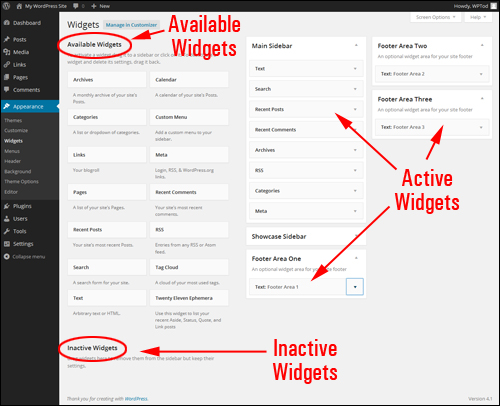
(Widgets Screen)
Step 4 – Add a Text widget.
Add a Text widget to your sidebar where you would like your button to display.
In the Available Widgets area, select the Text widget …
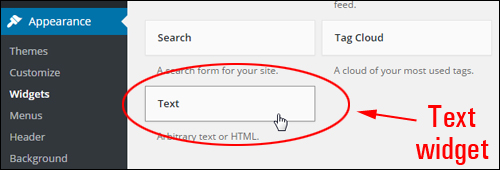
(Text widget)
Drag your Text widget to the Active Widgets section and release the widget at the very top of the Widget Area …

(Drag-and-drop your Text widget)
Step 5 – Configure the text widget settings.
Click on the Text widget title bar to configure the widget settings. Paste the code with the URLs to your contact page and graphic button into the text widget content area and click the save button …

Add a heading to your widget if you want (e.g. “Need Help?”, “Get Support”, etc.) and paste the code with the correct destination URLs into the large text box, then click Save when done …
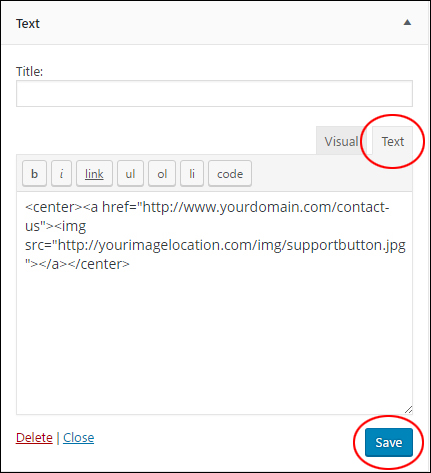
![]()
Note: Make sure to test all links before pasting scripts into the Text Widget, or the button won’t work.
*** If using WordPress version pre-4.8 ***
If you’re adding text with no formatting tags, you may want to tick the Automatically add paragraphs box to wrap each block of text in an HTML paragraph code (note: not required if you type in HTML code like we’re doing in this tutorial).
Here is some text added to a Text widget with Automatically add paragraphs option not selected …
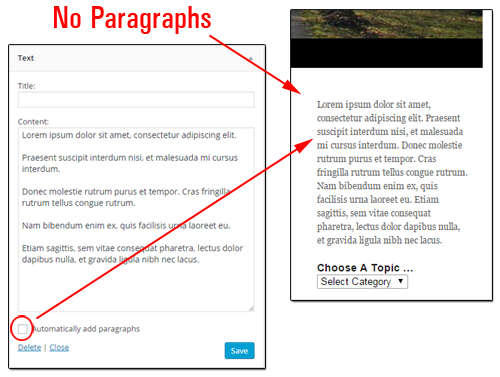
(Automatically add paragraphs box not checked)
Here is some text with Automatically add paragraphs box selected …
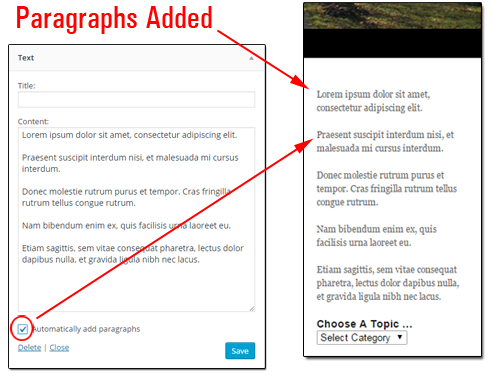
(Automatically add paragraphs box selected)
***
Step 6 – Refresh the browser.
After adding the text widget and content, visit your site and refresh the browser. If all links have been entered correctly, then the clickable support button will display at the top of your site’s sidebar menu …
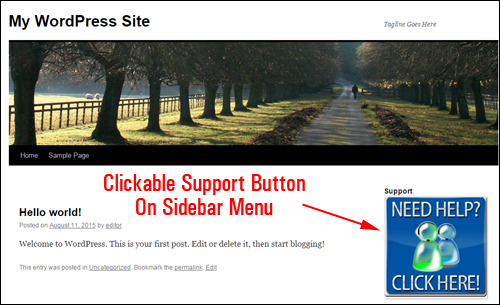
(Clickable support button widget on sidebar)
The above screenshot shows the contact button in the sidebar of a brand new WordPress site.
Step 7 – Test your button.
The final step is to make sure that the clickable button works. Test this by clicking on the graphic button. If you are taken to the contact page, then the text widget has been set up correctly …
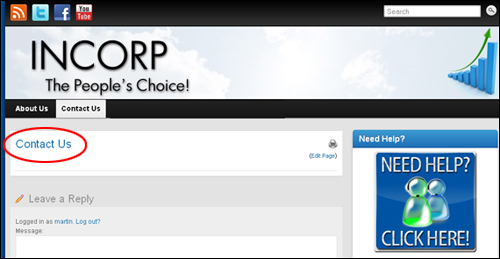
(Test your clickable button)
![]()
Text Widgets – Useful Tips:
If you want a new browser window to open up when visitors click on your help button (so they don’t leave the page they’re on), then change the button code from this:

To this (i.e. add the part that says: target=”_blank” in your text widget code):

When choosing images for your sidebar area, make sure that the width of your image does not exceed the width of the sidebar column, especially if you are using a non-responsive WordPress theme. Note that some themes may display different column widths depending on their templates and layout. Some sidebars may be wider or narrower. If your theme’s sidebar is narrower than the width of the graphic image, then you may have to either adjust the graphic size, or the column width to make graphics display correctly on your theme.
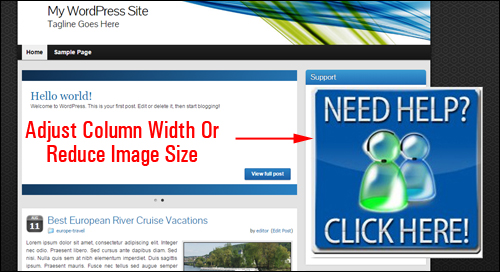
(Make sure the width of the image does not exceed the sidebar column width)
Additional Tips:
- If you don’t want the image to be centered inside your sidebar, delete the <center> and </center> tags from the beginning and end of the code. The image will then be aligned to its default settings (normally left-aligned).
- You can link your support button to any URL you want (e.g. to an external site, helpdesk, support forum, etc.) and change this anytime by replacing the links inside the text widget.
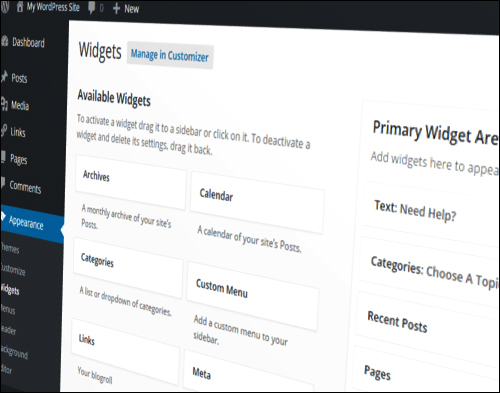
***
This is the end of part two of this tutorial on how to use Widgets.
To view Part 3, click this link:
***
"I am beyond impressed with what you have put together. I can tell that you put a ton of hard work into building what you have. You have the absolute best content on WordPress I have ever seen!" - Robert T. Jillie